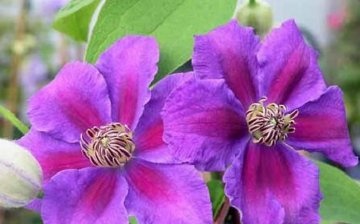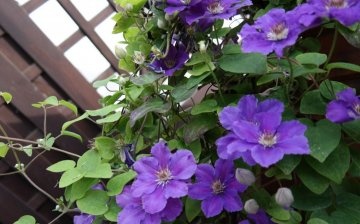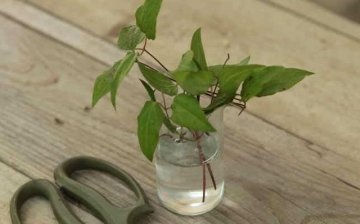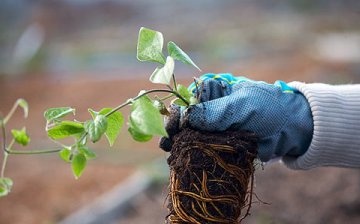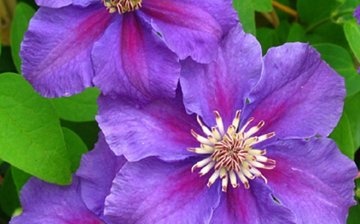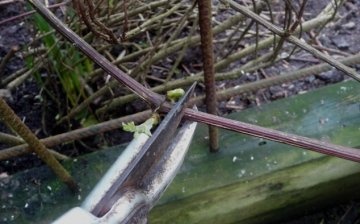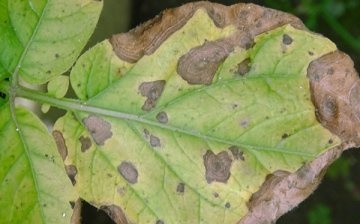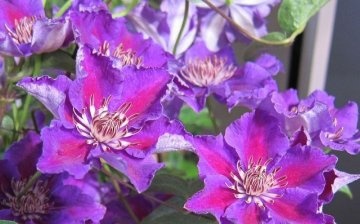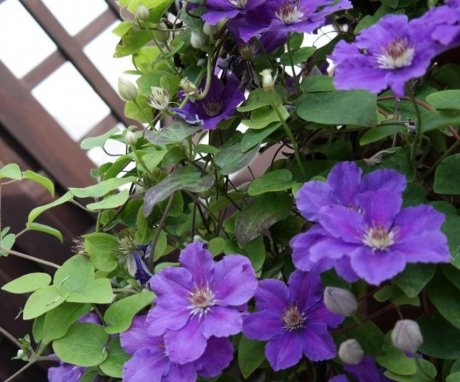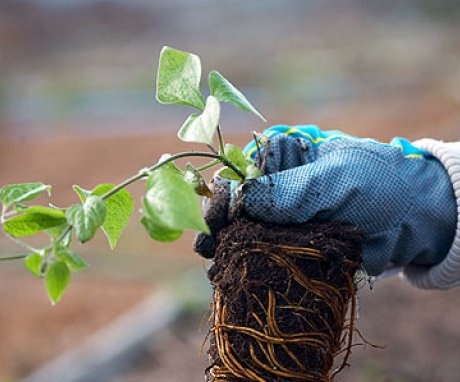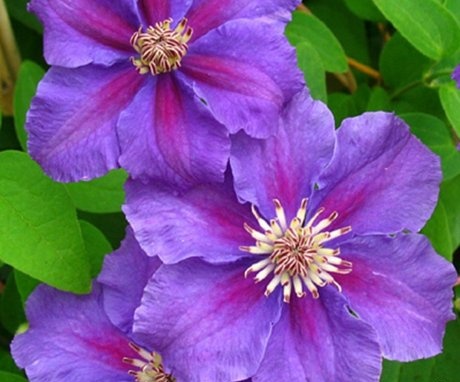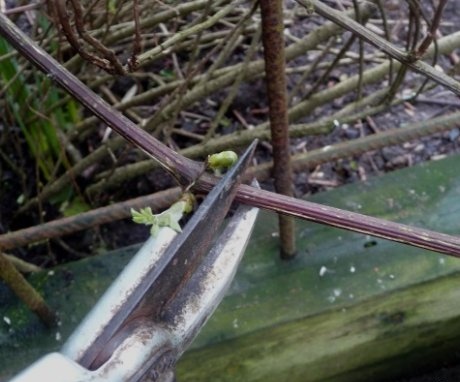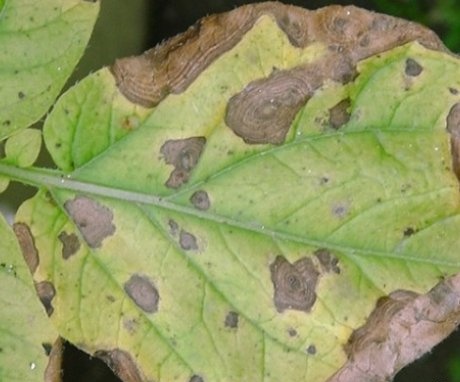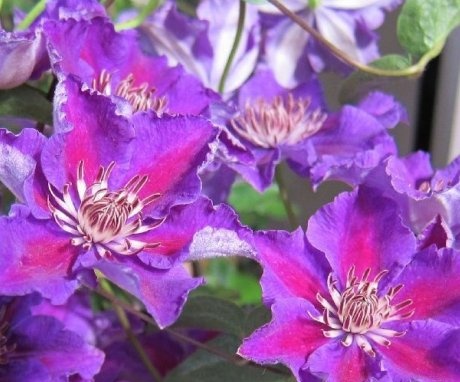Clematis Ashva (Ashva): all about growing a plant
Clematis serve as a decoration for a garden or flower beds. They dominate annuals both in the height of the vines and in the beauty of the flowers. One of the charming varieties is Clematis Ashva.
Content:
- Description and features of the plant
- Reproduction of clematis Ashva
- Planting recommendations
- Clematis care
- Preparing clematis for winter
- Diseases of clematis
- Uses of Clematis Ashva
Description and features of the plant
Clematis Ashva is a perennial compact vine. The popular name is clematis. Belongs to the Patens Group. Firmly clinging to the support with strong leaf petioles, the vine grows 1.5 to 2 m.
The variety is distinguished by beautiful purple-violet flowers.
A red vertical stripe is located on each petal. The average size is 5-8 cm. Each of them consists of five rounded petals with wavy edges. Pink filaments of stamens hold purple anthers.
Clematis pleases with flowering all summer, capturing the beginning of autumn, September. The buds are formed on the shoots of this year, which determines the peculiarities of pruning. It can grow in one place for up to 30 years.
Reproduction of clematis Ashva
Clematis with small flowers reproduce seeds... But for beautiful large-flowered varieties of clematis, this method is not suitable. It will not preserve the properties of the mother plant.
To get plants with varietal characteristics, you need to use a vegetative propagation method. This could be:
- Dividing the bush... It is carried out when the bush reaches the age of 5 years. With a sharp shovel, part of the roots, along with the shoots, are separated and transplanted to a new place. Such a bush will quickly begin to develop and bloom.
- Reproduction by layering. It takes patience and more time. In the middle of summer, the shoot is bent to the ground and attached with staples. Moisten or sprinkle with mulch. If the care for the layers is of high quality, the bush can be planted next year or in the fall.
- Reproduction cuttings... This is the most difficult breeding method. They are cut from strong and healthy shoots. Both lignified and green, but not very young parts are used. The lower corner is cut diagonally, the upper corner is cut at right angles. Each of the cuttings should have 2 nodes. The lower ends of the cuttings are processed for the rooters. They are planted in a greenhouse with moist, loose soil. Set at an angle. Maintain the temperature and humidity of the air and soil high. Cuttings root well in this way. Planted for growing no earlier than next year.
Planting recommendations
Best to plant clematis in the southern regions in autumn, in September. They will have time to take root before winter. If this is done in the spring, the plant can dry out from exposure to dry hot air. In northern regions, it is better to plant in spring. When planted in autumn, the plant may freeze.
The place for clematis is chosen sunny.
Only there he will be able to express himself in all his glory. It is advisable to choose a place for it, protected from cold northerly winds, with an exit to the south. Clematis Ashva tolerates partial blackout, but its crown must be in the sun for at least 5 hours a day.
Clematis grows well in front of a house or other building.But you can not plant a bush close to the wall. Water running down the roof will fall into root system, which will lead to stagnation of water and rotting of the roots. Leave a distance from buildings of at least 1.5 m. Clematis feels especially bad near solid metal fences. They can die from being close to a hot iron in the sun. Clematis loves fertile loamy soil. It must retain water, but not allow moisture to stagnate in the root system. Clematis will not grow on heavy acidic or salty soils.
Planting features:
- Prepare a pit for clematis with a depth of about 60 cm.A layer of drainage with a height of 20 cm is laid on the bottom.The earth taken out of the pit is mixed with compost or humus, add sand if the soil is clayey, or clay if it is sandy. 400 g of dolomite flour is added to the sour one. Introduce 0.5 l of wood ash and 100 g of complex mineral fertilizers.
- At the bottom of the pit, a mound of earth is poured over the drainage layer of fine expanded clay or crushed stone. Examine the roots of clematis. If they are dry, soak in water for a couple of hours.
- Set the clematis bush on a mound, straighten the roots along its sides. Gently sprinkle with the remaining earth, gradually compacting it.
- After planting, the root collar should be covered with earth. The older the clematis, the deeper it is planted. In winter, this will protect the plant from freezing, and in summer - from the scorching rays of the sun. And the shoots will be stronger and stronger.
- When planting a bush with a closed root system, the mound is not poured. They roll over the earthen lump so that it does not crumble.
- Water the near-trunk circle, cover it with a layer of mulch. It can be sawdust, a thick layer of cut grass. It is replenished periodically so that it is about 5 cm thick.
In the early years, the area under clematis can be protected from the sun by planting annuals with a shallow root system there. It can be marigold, calendula... Clematis cannot form a beautiful bush without a special support. It must be strong enough to withstand the green mass of shoots and leaves with flowers. You can make it from wood and fishing line, but it is better to immediately provide for a metal ladder. The distance between adjacent bushes is about 2 m.
Clematis care
The main stages of clematis care:
- You need to water after sunset 2 times a week, but little by little. With a lack of moisture, the flowers become smaller. The plant should not be flooded, especially in cases where the soil is not loose enough and drainage is not installed.
- When clematis starts up young shoots, their number is estimated. If the shoot released only one shoot for the first year, pinch its top. It begins to bush, side branches will begin to grow.
- At first, clematis needs a garter to support. When the plant gets stronger and begins to rise above 30 cm, the shoots will be able to find support themselves. But it is still better to keep an eye on the direction of their growth and adjust it as needed. Can be easily tied to the support with an 8-piece bandage.
- The plant is not fertilized for the first year after planting. The stock of nutrients in the hole during planting will be enough for growth and development until next year. Flower buds, if they appear, are removed the first year. This will allow the plant to grow the root system, and please it with flowering next year. Next year, you can bring humus under the bush, wood ash, mineral fertilizers... Fresh manure and peat must not be applied under clematis as fertilizers.
- The formation of a clematis bush is an important stage in the life of a plant. Perform it with a sharp, clean knife or pruner. During the growing season, sanitary pruning is carried out. Remove broken or weak branches. This variety belongs to clematis of the 3rd pruning group, which is called strongly pruned. Since the flower buds of Clematis Ashva are formed on the shoots of the current year, it makes no sense to leave the old shoots of last year.They are cut short, leaving 3 pairs of buds. The height above the ground of the shoots after cutting is 30-50 cm.
Preparing clematis for winter
Clematis variety Ashva is frost-resistant. It can withstand temperatures down to -30 ° C (frost resistance class 5). If the frosts are usually stronger in the region, they cover the bush more strongly. After pruning, it is spudded with earth to a height of 15 cm, after adding wood ash, humus or compost. In this case, the root neck of the clematis is covered.
With a steady transition of air temperature through 0 ° C, the plant can be covered with materials that allow air to pass through, and at the same time protect from frost.
These can be previously cut shoots (if they are not sick), sawdust, spruce branches. In the northern regions, sprinkle on top with peat, dry leaves, needles. Under such a shelter, the root and remaining shoots will not trample even during the spring thaws. In the spring, it is removed after the severe frosts have stopped. When it gets warmer, they remove the soil with which the bush was earthed.
Diseases of clematis
Clematis Ashva is disease resistant. But with improper care, it can be affected by fungal diseases:
- Withering is the most dangerous disease of clematis. It is caused by fungi that live in the soil. Fungi attack the root system. The disease manifests itself late, when the roots are already affected. Shoots wither, brown spots form on the leaves, which then turn black and dry.
- Rust appears as brown spots on the leaves.
- Powdery mildew can be seen by the white bloom on young leaves.
- Gray rot is manifested by brown spots on the leaves and shoots, which, at high humidity, becomes covered with gray fluffy mycelium.
- Alternaria - necrosis on leaves and shoots, covered with olive bloom.
- Septoria - the appearance of small rounded spots on the leaves
- Ascochitosis - leaf spot of clematis. Spots of irregular shape, bright yellow-brown color.
You can fight fungal diseases by spraying with preparations containing copper. This is Fast, bordeaux liquid, Oxyhom. They are also treated with Fundazol, Azocene at a concentration of 0.2%. You can dilute 300 g of green soap, 30 g of copper sulfate in a bucket of water.
Uses of Clematis Ashva
Due to its low growth and compactness, Clematis Ashva is suitable for growing in containers. Their width should be up to 50 cm, depth up to 80 cm. In such dishes, they can grow up to 5 years. In winter, you can store a container with clematis on the balcony, if the temperature there does not drop below zero.
In summer, they are used to decorate arches, pergolas, an entrance to a house or a courtyard. Columns, pyramids and other shapes can be formed from them. Clematis Ashva is planted in the background of mixborders, on balconies.
More information can be found in the video:



